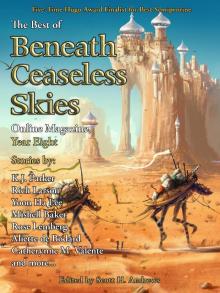


The Atlas of Middle-earth, Page 9
Karen Wynn Fonstad
In addition to the military losses, a long, hard winter settled in. From November through March, snow blanketed all the lands from Forochel to the Ered Nimrais. Food and fuel ran short, making famine a problem by midwinter. Loss of stock and late spring planting worsened the situation, and many thousands perished throughout the northwest.
The refugees hidden in the mountains of Rohan made desperate raids on the encamped enemy, and from such deeds came the fame of Helm Hammerhand.16 The weather was cruel to the enemy as well, and in the spring, turned to the favor of the Rohirrim, for rushing meltwaters flooded the plains. When a frantic band led by Helm’s nephew drove the Dunlendings from Edoras, the usurpers had no place to go. As the weather had been kinder south of the mountains, Gondor had been able to battle its attackers, and by spring were free to assist Rohan. With the arrival of the Dúnedain the last enemies were driven out. Even Isengard was regained and Saruman allowed to occupy Orthanc in hopes he could prevent its recapture.17
Remaining Events Prior to the Battle of Five Armies (2770–2940)
Troubles continued after the Days of Dearth: Ores in Rohan, 2800–2864; Harad against Gondor, 2885; Uruks in Ithilien, 2901; the Fell Winter, 2911.18 These were scattered and of limited importance. Far more notable were the activities of the Dwarves—not only as the prelude to The Hobbit but also as a part of the greater history. The defeat of the Ores at Moria in 2799 and later at Lonely Mountain in 2941 helped reduce the northern Ore troops available in the War of the Rings. The slaying of Smaug eliminated a creature that could have been used by Sauron with devastating effect.19 As these events are covered elsewhere, they have not been repeated here.20
Upper: DAYS OF DEARTH Lower: REMAINING EVENTS PRIOR TO THE HOBBIT
Left: MIGRATIONS Right: ANCESTRAL LANDS
Migrations of Hobbits
THROUGH THE AGES Hobbits lived quietly in their ancestral lands in the upper vales of Anduin.1 Over the years, three rather separate groups had developed: Fallohides, Harfoots, and Stoors. Their dwelling preferences were quite different, although they may not have been as separated as shown here. The Fallohides, the most northerly, were woodland people. The Harfoots chose the uplands, delving homes in the hillsides. The Stoors apparently lived farthest south and preferred the lowlands and riverbanks.2 The original Hobbit lands have been illustrated as extending on the west along the Great River, between the Gladden and the Carrock—the area inhabited at one time by the Rohirrim.3 The location was supported by the migration patterns: The Fallohides crossed the Misty Mountains north of Rivendell,4 while the Stoors climbed the Redhorn Pass.5 The Hobbits would probably have been perfectly happy continuing where they were, but Men were increasing, and nearby Greenwood the Great was becoming evil. So they began their Wandering Days.6 In T.A. 1050, some of the Harfoots went west into Eriador—some as far as Weathertop. They were joined about a century later by both the Fallohides and the Stoors. The Fallohides were few and mingled with the Harfoots and the Stoors of the Angle, but many Stoors settled apart near Tharbad in Dunland.7
In 1300, those living in the north were again forced to flee from Angmar. Some of the Stoors went south, joining their kin in Dunland; others returned to Wilderland, where they dwelt along the Gladden8—ancestors of the infamous Sméagol/Gollum;9 but most of the Hobbits moved west. The earliest and most important settlements were in Bree, and especially in Staddle.10 Many other pleasant villages were also established but later seem to have been abandoned and forgotten. In 1601 a large group of Hobbits moved from Bree to west of the Baraduin River,11 where thirty years later they were joined by Stoors of Dunland;12 and eventually, most of their people (but certainly not all)13 settled there in Sûza—The Shire.14
MIGRATIONS OF DURIN’S FOLK
Migrations of Dwarves
DURIN WAS THE FIRST of the Seven Dwarf Fathers to awake,1 and the other families were rarely mentioned.2 Some of Durin’s people went west in the First Age to the Ered Luin,3 but most remained in Khazad-dûm until T.A. 1980, when they delved too deep and released the Balrog, which had hidden there almost 5500 years before. Most went north to the Grey Mountains; but Thrain I, heir to the throne, wandered to the Lonely Mountain, where he established the Kingdom under the Mountain in 1999.4 In 2210, under his son Thorin I, many of the people joined their kindred in the rich Grey Mountains, where they prospered until 2570.5 When the king was killed by a cold-drake, the Dwarves again forsook their home. Some returned to Erebor with Thrór, the king’s eldest son, while others went east to the Iron Hills with a younger brother, Gr´or. Both communities prospered, and there was much commerce between them. To Thrór, Sauron gave the first-made of the Dwarf Rings, and with it a great hoard was built.6 Thus, their success was also their downfall, for in 2770 Smaug descended on the gate and routed the halls. Many escaped and scattered. Some accompanied Thrór, Thrain, and Thorin, who wandered south, stopping wherever work could be found.7
Twenty years later, when they were eking out a living in Dunland, Thrór returned to Moria and was beheaded by Ores. The Dwarves gathered from all corners—not only Durin’s folk, but also “Houses of other Fathers”—to destroy the Ores, ending with a great battle in 2799.8 Afterward Thrain led his folk west to the Blue Mountains, and their people began to reassemble. Yet once again, the evil power of the Ring was at work. Thrain led a small company east toward Erebor. They were pursued, and Thrain was captured and imprisoned in Dol Guldur, where the Ring was taken.9 Before his death he was found there by Gandalf,10 and that led to all that happened afterward—Thorin and Company, the Battle of Five Armies, and the resettlement of Erebor. Only two more large migrations remained: Balin’s disastrous attempt in 2989 to reoccupy Moria11 and Gimli’s colonization of the Glittering Caves.12
REGIONAL MAPS
Introduction
THE FOLLOWING REGIONAL MAPS include all of the place names of northwestern Middle-earth at the time of Bilbo’s and Frodo’s quests as mentioned in The Lord of the Rings and The Hobbit. Some of the names were locational, such as Far Harad, “far south”; some were descriptive, for example, Lithlad, “ash plain”; and some were inspired by nearby cultural features, as Ithilien, “moon land,” was named for Minas Ithil, “Tower of the Rising Moon.”1 The Shire and Rohan were the only political units with boundaries set by decree,2 so only their borders have been drawn.
Except for the Shire, no history has been given here. Instead, the accompanying texts explain the necessary decisions reached in drawing the physical base maps.3 Tolkien’s maps and text were compared with each other and with the Primary World, and the resulting landscape explained as if its formations were on Earth, rather than Middle-earth. The index marks shown here are 100 miles apart, as are Tolkien’s originals, but they are off 50 miles east-west and are 25 miles north on the north-south grid.4
The Shire
THE HOBBITS OF BREE obtained permission from the high king at Fornost in 1601 to settle the lands between the Brandywine River and the Far Downs. The boundaries shown were based on the stated distances: from the Far Downs to the Brandywine Bridge, forty leagues (120 miles); and from the western moors to the marshes in the south, fifty leagues (150 miles).5 The latter was measured from northwest to southeast, for had the line run due north-south it would have ended in hills, not marshes. The total area was about 21,400 square miles and was divided into four farthings. These have no official function but fit the subregions of the Shire: cooler, drier fields of the north; downlands of the west; sheltered croplands of the south; and the mixed lands of the east—woods, marshes, croplands, and quariies. Two adjacent areas were added to the Shire later: the Eastmarch (Buckland) and the Westmarch. Buckland was occupied in T.A. 2340, almost 700 years before the War of the Rings; while the Westmarch was granted by Aragorn in F.O. 32.6
Assorted references mentioned other settlements not shown on Tolkien’s map, so it has been assumed that they lay beyond its edges.7 The map even indicated the direction to several towns. Some topographic clues also were given: Michel Delving was
on the White Downs (so presumably Little Delving was also); Greenholm was in the Far Downs; Undertowers was at the east edge of the Tower Hills,7 the Emyn Beraid, where Gil-galad built the White Towers for Elendil upon his arrival from fallen Númenor.8 Each of these was placed along the Great East Road. The names themselves also have topographic references. Long Cleeve (a village occupied by the North Tooks)9 suggests a narrow valley cut through uplands; while Longbottom probably lay in a river bottom (though none was shown in that area other than the Brandywine). History, too, added insight. Longbottom was close enough to ship tobacco conveniently to Saruman via Sarn Ford; and Bullroarer Took defeated the Ores at the Battle of Greenfields in Northfarthing—probably not far from the north bounds.10
Lobelia Sackville-Baggins was originally a Bracegirdle from Hardbottle. The name means “hard dwelling”11 so the town was probably in some rocky area such as the downs; but was it north or south, White or Far Downs? The Bracegirdles were shown in the area west of Girdley Island,12 yet there was no indication of Hardbottle even in the nearby hills of Scary. The family owned many tobacco plantations, and the Sackville-Bagginses had land in South Farthing, so Hardbottle was placed on the White Downs at their south end.13 Another village associated with the Sackville-Bagginses was never mentioned by Tolkien: Sackville. The author used the name only as a surname, yet it seems reasonable to have been a village occupied by some members of the Sackville-Baggins family. The location was suggested by the Sackville-Bagginses’ tobacco land in South Farthing and the connection between the Bagginses and the Bracegirdles.
The Gamgees may have originally come from West Farthing. Their hometown of Gamwich was probably close to Tighfield, for there was much migration between the two. Two things suggested placement of Tighfield in West Farthing: From Tighfield one cousin moved to Northfarthing, and Sam said his uncle ran a “ropewalk over by Tighfield.”14
Once the villages had been placed, the cut-off roads were extended to them. The final product, although not authenticated, helps show the Shire as it was—well-settled, yet uncrowded, with lots of Hobbits but plenty of elbow room.
THE SHIRE Inset: POLITICAL DIVISIONS
Eriador
ERIADOR WAS THE NAME of all the lands between the Misty Mountains and the Blue.1 On Tolkien’s map the entire region appeared as one integrated whole, with a series of uplands whose longitudinal axes formed concentric rings.2 Many of those uplands were downs—the Far (Fox) Downs, the White Downs, the North Downs, the South Downs, and the Barrow-downs. Interspersed with the downlands were the Hills of Evendim and the Tower Hills, which also fit the ringlike pattern; and the Green-Hill Country and the hills of Scary, which did not fit, but instead appeared to run perpendicular to the downlands.3
Some readers may have heard of downs, without understanding what they are (other than hills of some sort). Downs occur when layers of sedimentary rock dip away from hills or mountains and begin eroding back, peeling off layer after layer of rock. The more resistant rock layers stand up as long ridges, sometimes extending hundreds of miles,4 while weaker sediments are eroded more quickly, forming lowlands. The ridges have a steep erosional face called the scarp and a long, gently dipping backslope.
Circular down ridges most often develop around a dome, such as the Wold and Downs near Fangorn. Less commonly, the concentric ridges could erode back from hills enclosing a broad round basin. Eriador centered on the Weather Hills, but also was almost encircled by the Blue Mountains on the west and northwest and the Misty Mountains on the east, northeast, and north; so its assorted downs could have been eroding back from either the central hills, or the outlying mountains, or both. The only clues given were about the Barrow-downs and Bree-hill and have been discussed in detail under that section. Evaluation of those two features has resulted in the illustration of Eriador as one gigantic round basin. This roughly circular shape was retained as a series of sedimentary layers eroded back over the eons of time—circular ridges and complementary lowlands.
The Weather Hills and the Midgewater Marshes
The sedimentary rock layer, which originally lay on the surface, was exposed to the erosional processes for the longest period of time. Gradually the outer edges of the layer were washed away, until at last the only portion left intact was the remnant towering almost a thousand feet above the surrounding landscape—the Weather Hills.5 The ridges were barren and rocky, indicating that the bedrock was possibly a flinty limestone, such as in the Flint Hills of eastern Kansas. This permeable stone would have allowed such rapid downward percolation of water that tree growth could not have been supported because of excessive soil aridity. Some of the water, collecting in a crack, could have formed the spring found by Sam and Pippin at the foot of Weathertop.6
The underlying layer was less resistant, and its erosion resulted in a lowland. The low gradients there, coupled with continental glaciation that would have disrupted stream courses, left numerous bogs and marshes—the best-known being the Midgewater Marshes.
The Barrow-downs and Bree-hill
The third group of sediments was relatively resistant. From them were formed the North Downs, Barrow-downs, and the South Downs. Their scarps have been illustrated facing northwest, southwest, and south, respectively—away from the center of the bowl formation. No downlands were shown east of the Weather Hills. Their absence could have been due to any of several variables, including changes in gradient, dip, or rock type.
Only the Barrow-downs were described in any detail by Tolkien. They had no surface drainage and were rather barren, supporting only grasses. Therefore they must have been composed of a highly permeable rock, such as chalk.7 To visualize the paths trod by the Hobbits, the orientation of the down ridges was of prime importance. Tolkien gave several clues, which had to be integrated: (1) As the Hobbits led their ponies north away from Bombadil’s house, the “hill-brow” was so steep they had to dismount to climb it; yet they were able to ride easily down the gentle slope behind. (2) Continuing north toward the road, they climbed the steep face and descended the long backslope of ridge after ridge of hills. (3) When standing atop a hill looking east, the Hobbits could see “ridge behind ridge.” (4) After leaving the hilltop on which they had been fogbound, the Hobbits rode north through a valley. (5) When Frodo heard cries for help he turned east and went steeply uphill.8 Almost all of these references indicate that the down scarps faced south and the ridges themselves ran east—west. The long north-south valley was a series of gaps through the ridges.9 This orientation, however, conflicts with the circular pattern of downs shown on the map, as well as with processes found in the real world—both of which require the downs to face more to the west. As a compromise, the long axis has been illustrated as trending from northwest to southeast—a reasonable explanation in view of the distinct southwesterly flow of the Withywindle.
Both the barren knob in the Old Forest and Bree-hill may have been associated geologically with the Barrow-downs. The knob was not far from the east edge of the forest; and when Bombadil guided the four Hobbits to the northwest edge of the downs, he told them they had to go only four miles to reach the Prancing Pony.10
The Shire
West of the inner ring of downs, the Brandywine lowland lay in an area of weak rock strata. The river course bulged westward from the North Downs to just north of Sarn Ford. Within the lowland two hilly areas cropped out: the Green-Hill Country and the hills of Scary. These probably were not downlands, for they ran perpendicular to the down ridges, and notably Tolkien did not call them downs. They may have been old hill remnants of highly resistant rock, covered by a veneer of weak sediments that later eroded away. In Northfarthing was still another formation—the North Moors.11 Moors are poorly drained uplands that can occur on granite.12 If that were the case in the Shire, the gray stones of the Green-Hill Country,13 the rock quarried near Scary,14 and the moorlands may all have been granite.
West of the Green-Hill Country lay the White Downs and the Far Downs. Nothing was told of the Far Downs, but
the White Downs were certainly chalk. Not only was the name, based on the color of the bedrock, indicative, but poor Mayor Whitfoot was buried in chalk when the roof of the Town Hole collapsed.15
The Tower Hills and the Hills of Evendim
Tolkien noticeably chose to call these hills, rather than downs, even though at first glance at the pictorial Lord of the Rings map they appear to fall into the same pattern of concentric rings. Even so, it is evident that the Hills of Evendim were much more extensive than any of the downlands. The ‘hatchured’ maps in The History are more revealing, and clearly show the more complex topography.16 As these hills lay near the Blue Mountains, they may have been folded rather than merely the product of erosion of sedimentary rock layers. The Tower Hills, although not more widespread, must also have been rather steep. In his dream, Frodo had to struggle to reach the White Towers on the ridge top.17
The Blue Mountains
The Ered Luin were little described, for they lay on the fringes of all Tolkien’s tales. Their elevation must have been lower than that of the Misty Mountains, for the Blue Mountains did not form as significant a barrier to the early westward migrations. The range appeared to run in twin ridges in places—especially as shown on the map from The Silmarillion. These have been illustrated in the atlas as upfolded with their peaks eroded down by streams—a breached anticline, an erosional pattern most commonly occurring in sedimentary rock. The outer layers seem to have been underlaid by metamorphic rocks formed in contact with numerous igneous intrusions. This environment is often necessary to produce veins of ore such as those mined by Dwarves from the earliest days.18














